
Amanita altipes, also called the yellow long-stem amanita, is a species of agaric fungus found in coniferous woodlands in southwestern China.
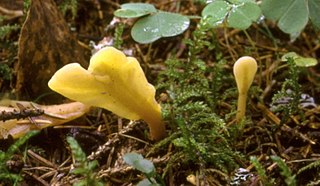
Spathularia flavida, commonly known as the yellow earth tongue, the yellow fan, or the fairy fan, is an ascomycete fungus found in coniferous forests of Asia, Europe and North America. It produces a small, fan- or spoon-shaped fruit body with a flat, wavy or lobed cream to yellow colored "head" raised on a white to cream stalk. The height is usually approximately 2–5 cm, and up to 8 cm. The fungus fruits on the ground in mosses, forest duff or humus, and fruit bodies may occur singly, in large groups, or in fairy rings. The spores produced by the fungus are needle-like, and up to 95 µm long. Several varieties have been described that differ largely in their microscopic characteristics. S. flavida has been described by authorities variously as inedible, of unknown edibility, or edible but tough.
Megalomyrmex symmetochus is a species of ant in the subfamily Myrmicinae. It is native to Panama. This ant is also known as the parasitic guest ant.

Gymnopilus braendlei is a species of agaric fungus in the family Hymenogastraceae that contains the hallucinogens psilocybin and psilocin. It was originally described by mycologist Charles Horton Peck as Flammula braendlei, from specimens found in the District of Columbia in 1902.

Amanita persicina, commonly known as the peach-colored fly agaric, is a basidiomycete fungus of the genus Amanita with a peach-colored center. Until c. 2015, the fungus was believed to be a variety of A. muscaria.
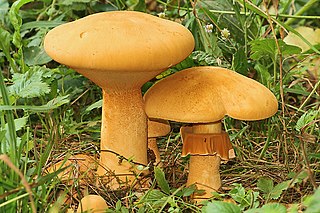
Phaeolepiota is a genus of fungi in the family Squamanitaceae. The genus is monotypic, containing the single species Phaeolepiota aurea. Commonly known as golden bootleg or golden cap, P. aurea is an agaric found throughout North America and Eurasia – often in groups and next to nettles. Molecular research, based on cladistic analysis of DNA sequences, shows that Phaeolepiota is close to and may be congeneric with Cystoderma.
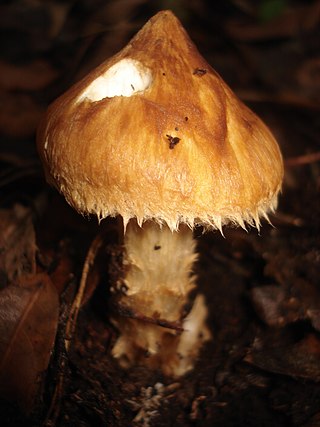
Squamanita is a genus of parasitic fungi in the family Squamanitaceae. Basidiocarps superficially resemble normal agarics but emerge from parasitized fruit bodies of deformed host agarics.

Amanita regalis, commonly known as the royal fly agaric or the king of Sweden Amanita, is a species of fungus in the family Amanitaceae. A. regalis has a scabby liver-brown cap and a stem which is yellow-ochre at the base, with patches or rings of patches. The fruit bodies somewhat resemble the smaller A. muscaria, which it was formerly regarded as a variety of.

Suillus pungens, commonly known as the pungent slippery jack or the pungent suillus, is a species of fungus in the genus Suillus. The fruit bodies of the fungus have slimy convex caps up to 14 cm (5.5 in) wide. The mushroom is characterized by the very distinct color changes that occur in the cap throughout development. Typically, the young cap is whitish, later becoming grayish-olive to reddish-brown or a mottled combination of these colors. The mushroom has a dotted stem (stipe) up to 7 cm (2.8 in) long, and 2 cm (0.8 in) thick. On the underside on the cap is the spore-bearing tissue consisting of minute vertically arranged tubes that appear as a surface of angular, yellowish pores. The presence of milky droplets on the pore surface of young individuals, especially in humid environments, is a characteristic feature of this species. S. pungens can usually be distinguished from other similar Suillus species by differences in distribution, odor and taste. The mushroom is considered edible, but not highly regarded.
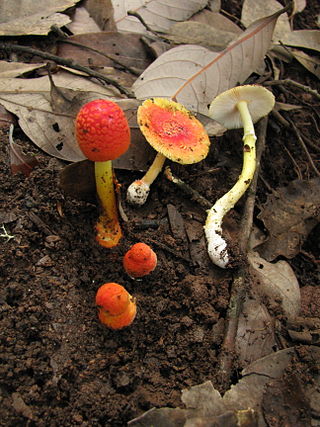
Amanita rubrovolvata, commonly known as the red volva amanita, is a species of fungus in the family Amanitaceae. The fungus produces small to medium-sized mushrooms, with reddish-orange caps up to 6.5 centimetres wide. The stems are up to 10 cm (4 in) tall, cream-coloured above the ring and cream to yellowish below it. The stem ends in a roughly spherical bulb at the base, which is covered with bright orange patches.
Dissoderma paradoxum, which has the recommended English name of powdercap strangler in the UK, is a species of fungus in the family Squamanitaceae. It is a parasitic fungus that grows on the fruit bodies of another fungus, Cystoderma amianthinum. It takes over the host and replaces the cap and gills with its own but retains the original stipe, creating in effect a hybrid between the two. The species was first described as Cystoderma paradoxum by American mycologists Alexander H. Smith and Rolf Singer in 1948, based on specimens collected in Mount Hood National Forest in Oregon. Cornelis Bas transferred the species to the genus Squamanita in 1965. Recent molecular research, based on cladistic analysis of DNA sequences, has however shown that the species does not belong in Squamanita sensu stricto but in the related genus Dissoderma. The species occurs in both North America and Europe.

Amanita flavella is a species of mycorrhizal fungus from family Amanitaceae. It has a convex lemon-yellow coloured cap up to 9 centimetres in diameter. They can also be yellowish-orange coloured and have crowded pale-yellow gills. The yellowish-white stipe is central and 9 cm tall; it is slightly bulbous, and enclosed into a volva. The yellowish-white ring is flared, ample, and membranous. The spores are 8.5–10 μm long and 6–6.5 μm wide, white, amyloid, and ellipsoid. The species is similar in appearance to A. flavoconia and A. flavipes.
Agaricus santacatalinensis is a species of agaric fungus. Described as new to science in 1998 by Edgardo Albertó, it is found in deciduous forests of Brazil, where it grows under privets (Ligustrum) and elm (Ulmus). The fruit bodies feature caps that are 7–12 cm (2.8–4.7 in) in diameter with felt-like surfaces. Somewhat unusually, the gills mature centrifugally. Initially, they are ochre yellow before turning dark brown after the spores mature. The stipe measures 8.5–12 cm (3.3–4.7 in) long by 1.5–2 cm (0.6–0.8 in) thick. It is white from the cap down to the ring, below which it becomes yellowish with orange tints. The base of the stipe has short yellowish rhizomorphs. The ring is membranous, measuring 1–2 mm thick. The edibility of the mushroom is unknown.
Cystoderma granuliferum is a species of fungus in the family Squamanitaceae. It is found in the Amazonian region of Ecuador, where it grows on the rotting wood of dicotyledons. The fungus was described as new to science in 1999 by mycologists Cornelis Bas and Thomas Læssøe. Molecular research, based on cladistic analysis of DNA sequences, has shown that it belongs in the genus Cystoderma.
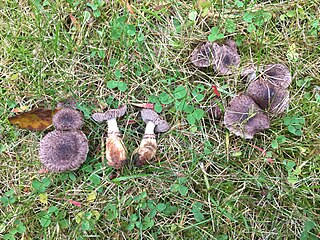
Dissoderma is a genus of parasitic fungi in the family Squamanitaceae. Basidiocarps superficially resemble normal agarics but emerge from parasitized fruit bodies of deformed host agarics.

The Squamanitaceae are a family of fungi in the order Agaricales. All species in the family are agarics. Species in two genera, Dissoderma and Squamanita, are parasitic on other agarics. Members of the Squamanitaceae are found worldwide.
Amanita viscidolutea is a species of agaric fungus in the family Amanitaceae native to Brazil.

Dissoderma odoratum is a species of fungi in the family Squamanitaceae. It is a distinctly strong-smelling species with small, purple sporocarps. The fungus parasites in the sporocarps of the veiled hebeloma, which are deformed by the parasitic fungus. Dissoderma odoratum is mostly found in Europe but has also been found from the United States. The fungus is a rare species that is classified as endangered in several European countries.











